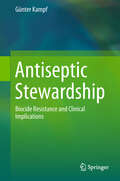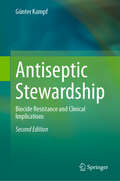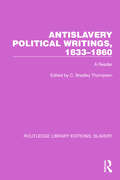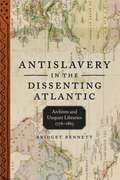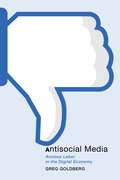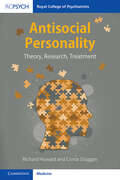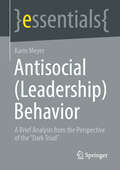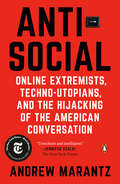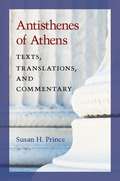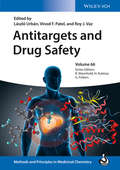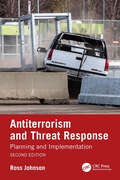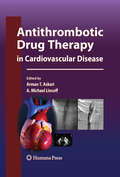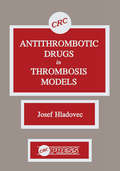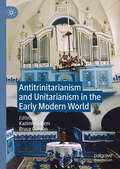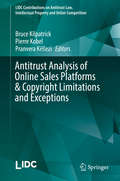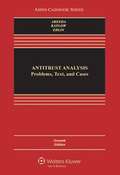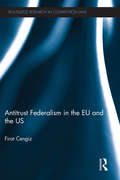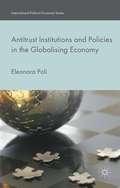- Table View
- List View
Antisepsis, Disinfection, and Sterilization: Types, Action, and Resistance (ASM Books)
by Gerald McDonnellAntisepsis, Disinfection, and Sterilization: Types, Action, and Resistance, by Gerald E. McDonnell, is a detailed and accessible presentation of the current methods of microbial control. Each major category, such as physical disinfection methods, is given a chapter, in which theory, spectrum of activity, advantages, disadvantages, and modes of action of the methods are thoroughly and clearly presented. Sufficient background on the life cycles and general anatomy of microorganisms is provided so that the reader who is new to microbiology will better appreciate how physical and chemical biocides work their magic on microbes. Other topics in the book include: Evaluating the efficacy of chemical antiseptics and disinfectants, and of physical methods of microbial control and sterilization. Understanding how to choose the proper biocidal product and process for specific applications. Classic physical and chemical disinfection methods, such as heat, cold, non-ionizing radiation, acids, oxidizing agents, and metals. Newer chemical disinfectants, including, isothiazolones, micro-and nano-particles, and bacteriophages as control agents. Antisepsis of skin and wounds and the biocides that can be used as antiseptics. Classic methods of physical sterilization, such as, moist heat and dry heat sterilization, ionizing radiation, and filtration, along with newer methods, including, the use of plasma or pulsed light. Chemical sterilization methods that use ethylene oxide, formaldehyde, or a variety of other oxidizing agents. A detailed look at the modes of action of biocides in controlling microbial growth and disrupting microbial physiology. Mechanisms that microorganisms use to resist the effects of biocides. The second edition of Antisepsis, Disinfection, and Sterilization: Types, Action, and Resistance is well suited as a textbook and is outstanding as a reference book for facilities managers and application engineers in manufacturing plants, hospitals, and food production facilities. It is also essential for public health officials, healthcare professionals, and infection control practitioners.
Antiseptic Stewardship: Biocide Resistance and Clinical Implications
by Günter KampfVarious antiseptic agents, such as chlorhexidine, are used for different applications, e.g. in healthcare, veterinary medicine, animal production and household products, including cosmetics. However, not all antiseptic agents provide significant health benefits, especially in some products used in human medicine (alcohol-based hand rubs, antimicrobial soaps). While some products (antimicrobial soaps, surface disinfectants, instrument disinfectants, wound antiseptics) may contain one or more biocidal agents with a comparable antimicrobial efficacy but large differences in their potential for microbial adaptation and tolerance. An increased bacterial resistance has been described for various antimicrobial agents, sometimes including a cross-resistance to antibiotics. The book is the first comprehensive reference resource on antiseptic agents, including their efficacy, natural and acquired resistance, adaptation, and cross-resistance. It also discusses their and appropriate use in terms of a balance between their efficacy and the risk of acquired bacterial resistance / tolerance. Focusing on human and veterinary medicine and household products, it helps readers make informed decisions concerning against antiseptic products based on their composition. The book contributes to reduce any unnecessary selection pressure towards emerging pathogens and to keep the powerful antiseptic agents for all those applications that have a clear benefit (e.g. reduction of healthcare-associated infection).
Antiseptic Stewardship: Biocide Resistance and Clinical Implications
by Günter KampfThis updated and expanded second edition of Antiseptic Stewardship serves as a comprehensive reference guide to common biocidal active substances and antiseptic agents, examining their antimicrobial efficacy and potential to induce cell tolerance, including cross-tolerance to other biocidal agents, as well as cross-resistance to antibiotics. In addition, the book discusses the appropriate and targeted use of biocidal active substances by balancing their expected health benefits against the likelihood of clinically relevant resistance, including misuse and overuse of some products during the COVID-19 pandemic. This guide, which focuses on human, veterinary and household products, helps readers make informed decisions about disinfectants and antiseptic products based on their composition. Various biocidal active substances and antiseptic agents are used for disinfection and antisepsis in healthcare, veterinary medicine, animal production and household products. However, not all of them provide significant health benefits, especially for some products used in human medicine. Antimicrobial soaps, surface disinfectants, instrument disinfectants and wound antiseptics may contain one or more biocidal active ingredients with comparable antimicrobial efficacy, but with large differences in their potential for microbial adaptation and tolerance. Increased bacterial tolerance has been described for several biocidal active substances and antiseptics, sometimes including cross-resistance to antibiotics. The book is therefore intended to help reduce unnecessary selection pressure on emerging pathogens, including by describing non-biocidal alternatives for specific antimicrobial applications, with the aim of retaining the powerful biocidal agents and antiseptics for those applications where there is a clear health benefit (e.g. reduction of healthcare-associated infections). The book addresses healthcare, industrial and veterinary professionals as well as educated laypersons interested in efficient and controlled disinfection strategies.
Antislavery Political Writings, 1833–1860: A Reader (Routledge Library Editions: Slavery #3)
by Thompson C. BradleyAntislavery Political Writings, first published in 2004, presents the best speeches and writings of the leading American antislavery thinkers, activists and politicians in the years between 1830 and 1860. These chapters demonstrate the range of theoretical and political choices open to antislavery advocates during the antebellum period.
Antislavery in the Dissenting Atlantic: Archives and Unquiet Libraries, 1776–1865 (Antislavery, Abolition, and the Atlantic World)
by Bridget BennettBridget Bennett’s Antislavery in the Dissenting Atlantic explores the impact of a historically situated set of transatlantic networks, chiefly centered on prominent communities of religious nonconformists in England and Pennsylvania in the decades between the American Revolution and American Civil War. The study reveals the alliances forged out of progressive religious and political commitments to dissent that enabled expansive connections across the Atlantic world. These developments emerged from local proximities and combined an optimistic devotion to social justice and education with a global vision. Bennett’s work offers an original and innovative reading of transatlantic partnerships, exploring obscure writings, overlooked individuals, and the cultures of the everyday, while also affording fresh understandings of familiar antislavery texts.
Antisocial
by Jillian BlakeWhat if your greatest secrets became public? For the students at Alexandria Prep, a series of hacks leads to a scandalous firestorm—and the students are left wondering whose private photos and messages will be exposed next. It’s Pretty Little Liars meets WikiLeaks.Senior spring at Alexandria Prep was supposed to be for sleeping through class and partying with friends. But for Anna Soler, it’s going to be a lonely road. She's just been dumped by her gorgeous basketball star boyfriend—with no explanation. Anna's closest friends, the real ones she abandoned while dating him, are ignoring her. The endearing boy she’s always had a complicated friendship with is almost too sympathetic. But suddenly Anna isn’t the only one whose life has been upended. Someone is determined to knock the kings and queens of the school off their thrones: one by one, their phones get hacked and their personal messages and photos are leaked. At first it's funny—people love watching the dirty private lives of those they envy become all too public. Then the hacks escalate. Dark secrets are exposed, and lives are shattered. Chaos erupts at school. As Anna tries to save those she cares about most and to protect her own secrets, she begins to understand the reality of our always-connected lives: Sometimes we share too much.
Antisocial Behavior
by Benjamin B. WolmanAntisocial behavior takes on many forms, from rebellious teens with green hair and pierced skin to the truly dangerous homicidal individuals whose horrible stories fill our newspapers. Parents worry about their children as they are exposed to the heatedclimate of violence in contemporary society, a time of decaying morals and values.The rise in sociopathic behavior among adults and children, whether in tense inner cities or in tranquil suburban and rural settings, is masterfully chronicled by Dr. Benjamin B. Wolman, a leading psychologist and noted national expert who has studied these trends for over half a century. "There is a growing incidence of sociopathic antisocial behavior . . . coupled with an attitude of moral apathy," Dr. Wolman asserts. He cites international statistics pointing to a showdown between dangerous individuals-the violent, the charming, and the passive-and the societies that create them.How has the spread of democratic ideals actually increased the potential for antisocial behavior? What social and cultural factors must be changed if free societies are to reduce this alarming trend?Rather than simply complain about the problem, Dr. Wolman examines the familial and societal causes, and proposes clear-cut solutions to the problem-including radical changes to our educational system and the mass media.
Antisocial Behavior and Mental Health Problems: Explanatory Factors in Childhood and Adolescence
by Rolf Loeber David P. Farrington Magda Stouthamer-Loeber Welmoet B. Van KammenEpidemiological surveys have provided key information about the prevalence and degree of seriousness at different ages of a wide array of problem behaviors such as delinquency, substance use, early sexual involvement, and mental health disorders. Knowledge of the extent of these problems and changes in their course over time is important. In its absence, interventions and health planning in general can be difficult. Understanding which risk and protective factors are relevant to which problem behaviors is also essential for the formulation of theories that constitute the basis of intervention. This book draws on the results of the major Pittsburgh Youth Study complemented by follow-up tracking of juvenile court records for more than six years, to address the following questions: *What is the prevalence and age of onset of delinquency, substance use, and early sexual behavior for three samples of boys age 8, 11, and 14? What are the average mental health problems for these ages? How strong are the relationships among these problem behaviors in each of the samples? *Which variables best explain individual differences among the boys in their manifestations of delinquency, substance use, early sexual behavior, and mental health problems? To what extent do explanatory factors vary with age? How accurately can boys with different outcomes be identified by risk scores based on hierarchical multiple regressions? *To what extent are explanatory factors associated with one outcome that are also associated with other outcomes? Are explanatory factors that are especially characteristic of a multiproblem group of boys--who display many different problem behaviors--different from explanatory factors associated with boys with few problems? *Do the results fit a general theory of juvenile problem behaviors, or is a differentiated theory more applicable?
Antisocial Media: Anxious Labor in the Digital Economy (Postmillennial Pop #21)
by Greg GoldbergThe debate surrounding the transformation of work at the hands of digital technology and the anxieties brought forth by automation, the sharing economy, and the exploitation of leisure We have been told that digital technology is now threatening the workplace as we know it, that advances in computing and robotics will soon make human labor obsolete, that the sharing economy, exemplified by Uber and Airbnb, will degrade the few jobs that remain, and that the boundaries between work and play are collapsing as Facebook and Instagram infiltrate our free time.In this timely critique, Greg Goldberg examines the fear that work is being eviscerated by digital technology. He argues that it is not actually the degradation or disappearance of work that is so troubling, but rather the underlying notion that society itself is under attack, and more specifically the bonds of responsibility on which social relations depend. Rather than rushing to the defense of the social, however, Goldberg instead imagines the appeal of refusing the hard work of being a responsible and productive member of society.
Antisocial Media: Crime-watching in the Internet Age (Palgrave Studies in Crime, Media and Culture)
by Mark A. WoodThis book provides a cutting-edge introduction to Internet-facilitated crime-watching and examines how social media have shifted the landscape for producing, distributing, and consuming footage of crime. In this thought-provoking work, Mark Wood examines the phenomenon of antisocial media: participatory online domains where footage of crime is aggregated, sympathetically curated, and consumed as entertainment. Focusing on Facebook pages dedicated to hosting footage of street fights, brawls, and other forms of bareknuckle violence, Wood demonstrates that to properly grapple with antisocial media, we must address not only their content, but also their software. In doing so, this study goes a long way to addressing the fundamental question: how have social media changed the way we consume crime? Synthesizing criminology, media theory, software studies, and digital sociology, Antisocial Media is media criminology for the Facebook age. It is essential reading for students and scholars interested in social media, cultural criminology, and the crime-media interface.
Antisocial Personality: Theory, Research, Treatment
by Richard Howard Conor Duggan<p>It remains something of a mystery why some individuals behave in persistently malevolent and destructive ways towards their fellows, causing untold harm both to themselves and their victims. This book argues that to understand the roots of antisocial behaviour, one first has to understand what motivates the majority of people to behave prosocially - to think, feel and act in non-malevolent ways. All people are motivated to seek emotion goals - to feel thrilled and excited, to feel safe from the threats of others, to feel a sense of justice, and to feel gratified. However some individuals seek these emotion goals in antisocial ways due to an excess of emotions such as distrust, boredom, greed, vengeance and insecurity. The authors outline interpersonal and neurobiological correlates of antisocial personality, its developmental antecedents, its frequency and pattern across different societies and cultures, and different approaches to its treatment and rehabilitation.</p>
Antisocial, Narcissistic, and Borderline Personality Disorders: A New Conceptualization of Development, Reinforcement, Expression, and Treatment
by Daniel J. FoxThis book provides a framework for scholars and clinicians to develop a comprehensive and dynamic understanding of antisocial, narcissistic, and borderline personality disorders, by seeing personality as a dual, as opposed to a singular, construct. Converging the two separate research and clinical diagnostic systems into a wholistic model designed to reach reliable and valid diagnostic conclusions, the text examines adaptive and maladaptive personality development and expression, while addressing the interpersonal system that keeps the pathology from extinguishing. Each chapter will discuss core and surface content, origin and symptom manifestation, system and pathology perpetuation, and online behavior expression, concluding with practical guidance on treatment success and effective approaches. Seasoned and tyro researchers and clinicians will be challenged to explore the utility of the DSM-5 alternative model of personality disorders and apply it to further the understanding of these complex, and often destructive, disorders.
Antisocial: A Brief Analysis from the Perspective of the "Dark Triad" (essentials)
by Karin MeyerNarcissism is considered a widespread phenomenon at leadership levels, where it is represented disproportionately compared to the general population. Furthermore, younger emerging (leadership) talents exhibit significantly higher levels of narcissism than older generations have shown to date. At the same time, traits of the Dark Triad (narcissism, machiavellianism, and psychopathy) often do not occur in isolation, but rather in combination. For this reason, companies should rethink their personnel selection, management, and development practices today. This analysis will therefore highlight the characteristics and behavior patterns of ruthless individuals from the Dark Triad, as well as possible approaches for intervention and prevention.
Antisocial: Online Extremists, Techno-Utopians, and the Hijacking of the American Conversation
by Andrew MarantzFrom a rising star at The New Yorker, a deeply immersive chronicle of how the optimistic entrepreneurs of Silicon Valley set out to create a free and democratic internet--and how the cynical propagandists of the alt-right exploited that freedom to propel the extreme into the mainstream. <P><P>For several years, Andrew Marantz, a New Yorker staff writer, has been embedded in two worlds. The first is the world of social-media entrepreneurs, who, acting out of naïvete and reckless ambition, upended all traditional means of receiving and transmitting information. The second is the world of the people he calls "the gate crashers"--the conspiracists, white supremacists, and nihilist trolls who have become experts at using social media to advance their corrosive agenda. <P><P>Antisocial ranges broadly--from the first mass-printed books to the trending hashtags of the present; from secret gatherings of neo-Fascists to the White House press briefing room--and traces how the unthinkable becomes thinkable, and then how it becomes reality. Combining the keen narrative detail of Bill Buford's Among the Thugs and the sweep of George Packer's The Unwinding, Antisocial reveals how the boundaries between technology, media, and politics have been erased, resulting in a deeply broken informational landscape--the landscape in which we all now live. <P><P>Marantz shows how alienated young people are led down the rabbit hole of online radicalization, and how fringe ideas spread--from anonymous corners of social media to cable TV to the President's Twitter feed. Marantz also sits with the creators of social media as they start to reckon with the forces they've unleashed. Will they be able to solve the communication crisis they helped bring about, or are their interventions too little too late?
Antisthenes Of Athens: Texts, Translations, And Commentary
by Susan PrinceAntisthenes of Athens (c. 445-365 BCE) was a famous ancient disciple of Socrates, senior to Plato by fifteen years and inspirational to Xenophon. He is relevant to two of the greatest turning points in ancient intellectual history, from pre-Socraticism to Socraticism, and from classical Athens to the Hellenistic period. A better understanding of Antisthenes leads to a better understanding of the intellectual culture of Athens that shaped Plato and laid the foundations for Hellenistic philosophy and literature as well. Antisthenes wrote prolifically, but little of this text remains today. Susan Prince has collected all the surviving passages that pertain most closely to Antisthenes' ancient reputation and literary production, translates them into English for the first time, and sets out the parameters for their interpretation, with close attention to the role Antisthenes likely played in the literary agenda of each ancient author who cited him. This is the first translation of Antisthenes' remains into English. Chapters present the ancient source, the original Greek passage, and necessary critical apparatus. The author then adds the modern English translation and notes on the context of the preservation, the significance of the testimonium, and on the Greek. Several new readings are proposed. Antisthenes of Athens will be of interest to anyone seeking to understand Antisthenes and his intellectual context, as well as his contributions to ancient literary criticism, views on discourse, and ethics.
Antitargets and Drug Safety
by Laszlo Urban Roy J. Vaz Vinod PatelWith its focus on emerging concerns of kinase and GPCR-mediated antitarget effects, this vital reference for drug developers addresses one of the hot topics in drug safety now and in future. Divided into three major parts, the first section deals with novel technologies and includes the utility of adverse event reports to drug discovery, the translational aspects of preclinical safety findings, broader computational prediction of drug side-effects, and a description of the serotonergic system. The main part of the book looks at some of the most common antitarget-mediated side effects, focusing on hepatotoxicity in drug safety, cardiovascular toxicity and signaling effects via kinase and GPCR anti-targets. In the final section, several case studies of recently developed drugs illustrate how to prevent anti-target effects and how big pharma deals with them if they occur. The more recent field of systems pharmacology has gained prominence and this is reflected in chapters dedicated to the utility in deciphering and modeling anti-targets. The final chapter is concerned with those compounds that inadvertently elicit CNS mediated adverse events, including a pragmatic description of ways to mitigate these types of safety risks. Written as a companion to the successful book on antitargets by Vaz and Klabunde, this new volume focuses on recent progress and new classes, methods and case studies that were not previously covered.
Antiterrorism and Threat Response: Planning and Implementation
by Ross JohnsonOne of the single greatest challenges to security professionals in the 21st century is terrorism. In the last several years, we have heard a lot about the importance of preparing for terrorist attacks. This book offers a way to prevent terrorist attacks. Providing security managers with a clear and simple methodology to protect their organizations,
Antiterrorism and Threat Response: Planning and Implementation
by Ross JohnsonAs security professionals, we tend to get seduced by the beauty of our technology. We go to trade exhibitions filled with the latest innovations and marvel at what we see without understanding how it fits in with what we do. It’s both overwhelming and distracting, like trying to learn to cook by walking through a grocery store.This focus on technology teaches us to judge the effectiveness of physical protection systems by the strength of the barriers, the acuity of the cameras, and the sensitivity of the sensors. Terrorists and criminals look for something else entirely, though: where we see strength, they find weakness and vulnerability. We are looking at the same things, but not seeing the same things. If we want to stop them, we need to know more than how they work. We need to learn to see the way they see.A physical protection system - that collection of people, sensors, barriers, policies, and technology – is a lot like a piano: and you cannot tell if a piano is in tune by looking at it. You have to play it. The major contribution of Antiterrorism and Threat Response: Planning and Implementation, 2e is the detailed instruction and practical advice on how to see the weaknesses and vulnerabilities in physical protection systems and upgrade them to meet the challenges of terrorists and criminals. Key features of this book are: Provides professionals with the background to understand how terrorists think and operate, in order to best coordinate their counterterrorism efforts and antiterrorism strategies Examines difficult new problems facing security professionals: such as the use of drones, guns, and the internet as a tool of both recruitment and indoctrination Teaches the reader how to step outside the security department to find and fix weaknesses and vulnerabilities in physical protection systems Introduces and discusses security management and insider threat risk management programs This is the advanced course in protecting physical assets from terrorists and criminals.
Antithrombotic Drug Therapy in Cardiovascular Disease (Contemporary Cardiology)
by A. Michael Lincoff Arman T. AskariSubstantial morbidity and mortality remains associated with thrombotic events has stimulated the rapid expansion of the available armamentarium to combat pathologic thrombosis. Pathologic thrombosis plays an essential role in the pathogenesis of acute coronary syndromes (ACS), ischemic complications of percutaneous coronary intervention (PCI), venous thromboembolic disease, and embolic complications of arrhythmias and various cardiomyopathies. Written by experts in the field, Antithrombotic Drug Therapy in Cardiovascular Disease carefully examines individual and various combinations of the available antithrombotic regimens including fibrinolytic agents, antiplatelet therapies (aspirin, thieneopyridines, glycoprotein IIb/IIIa inhibitors), and anticoagulant therapies (unfractionated heparin, low-molecular-weight heparins, direct thrombin inhibitors, and synthetic factor X inhibitors), non-ST-segment elevation (NSTE) ACS and ST-segment elevation myocardial infarction (STEMI). A detailed overview, Antithrombotic Drug Therapy in Cardiovascular Disease presents the evidence demonstrating the efficacy of available antithrombotic therapies in specific disease states such as atrial fibrillation, cardiomyopathy, valvular heart disease, and heparin-induced thrombocytopenia (HIT).
Antithrombotic Drugs in Thrombosis Models
by Josef HladovecAntithrombotic Drugs in Thrombosis Models presents a critical review of the use of thrombosis models and an original, highly sensitive methodology for testing antithrombotics based on a more adequate understanding of thrombotic processes. The methods form an integrated system stressing particularly the plurifactorial and global character of thrombosis and the key role of a generalized mild endothelial lesion. Packed with illustrations, this book documents the effectiveness of the system through the screening of a series of acknowledged and potential antithrombotics, and includes a unique study of their mutual combinations. Special emphasis is placed on the importance of biomodels for preliminary testing of antithrombotics. This book is particularly useful to researchers in pharmacology and the pharmaceutical industry; however, those interested in drug research and the field of cardiovascular medicine will benefit as well.
Antitrinitarianism and Unitarianism in the Early Modern World
by Bruce Gordon Kazimierz BemThis collection offers an innovative and fresh interpretation of Antitrinitarian and rational dissent in the early modern world. The central themes focus on the fierce debates surrounding Antitrinitarianism and Unitarianism that emerged from the Reformation and the lived cultures of these dissenting movements. The chapters take an interdisciplinary approach addressing ideas in context, their reception and appropriation, and the diverse and often conflicting visions of Christianity. Drawing on previously unused sources, many from Eastern Europe and often in inaccessible languages, this book challenges our understanding of dissent as marginal and eccentric and places it at the center of contesting convictions about the nature of religious reform.
Antitrust Analysis of Online Sales Platforms & Copyright Limitations and Exceptions (LIDC Contributions on Antitrust Law, Intellectual Property and Unfair Competition)
by Bruce Kilpatrick Pierre Kobel Pranvera KëlleziThis book gathers international and national reports from across the globe on key questions in the field of antitrust and intellectual property.The first part discusses the application of competition law to online sales platforms, which is increasingly a focus for anti-trust authorities around the world. A detailed international report explores which are the major challenges for competition law generated by the growth of online platforms. It provides an excellent comparative study of this complex and challenging subject.The second part of the book gathers contributions from various jurisdictions on the topic “To what extent do current exclusions and limitations to copyright strike a fair balance between the rights of owners and fair use by private individuals and others ?" This section presents an international report, which offers an unparalleled comparative analysis of this topic, bringing together common themes and contrasting the various national provisions dealing with exceptions to copyright, amongst other things.The book also includes the resolutions passed by the General Assembly of the International League of Competition Law (LIDC) following a debate on each of these topics, which include proposed solutions and recommendations. The LIDC is a long-standing international association that focuses on the interface between competition law and intellectual property law, including unfair competition issues.
Antitrust Analysis: Problems, Text, and Cases Seventh Edition
by Louis Kaplow Aaron S. Edlin Phillip E. AreedaAspen Casebook Series This text continues to be revised by two of the leading lawyer economists of the early 21st century. This traditional casebook is also known for its pedagogy (cases, explanatory text, and problems) and insightful text that convey essentials background information along with necessary economic principles. Many important contemporary discussions have been updated, such as improved intellectual property, market definition, and collusion.
Antitrust Federalism in the EU and the US (Routledge Research in Competition Law)
by Firat CengizThe EU and the US are the preeminent examples of multi-level polities and both have highly developed competition policies. Despite these similarities however, recent developments suggest that they are moving in different directions in the area of antitrust federalism. This book examines multi-level governance in competition policy from a comparative perspective. The book analyses how competition laws and authorities of different levels - the federal and the state levels in the US and the national and the supranational levels in the EU - interact with each other. Inspired by the increasingly divergent policy developments taking place on both sides of the Atlantic, the author asks whether the EU and the US can draw policy lessons from each other’s experiences in antitrust federalism. Antitrust Federalism in the EU and the US reveals the similarities and differences between the European and American models of antitrust federalism whilst employing policy network models in its comparative analysis of issues such as opacity and accountability in networks. The book is essentially multidisciplinary in its effort to initiate dialogue between the Law and Political Science literatures in this field. This book will be of particular interest to academics, students and practitioners of Competition Law, Constitutional Law and Political Science.
Antitrust Institutions and Policies in the Globalising Economy (International Political Economy Series)
by Eleonora PoliEleonora Poli analyses how ideas and material interests have come to determine the evolution of antitrust policies in the USA, EU, Japan and BRICS. She argues that three major economic crises together with market globalisation have changed governments' perceptions of market competition, giving rise to a neo-liberal global phase.

